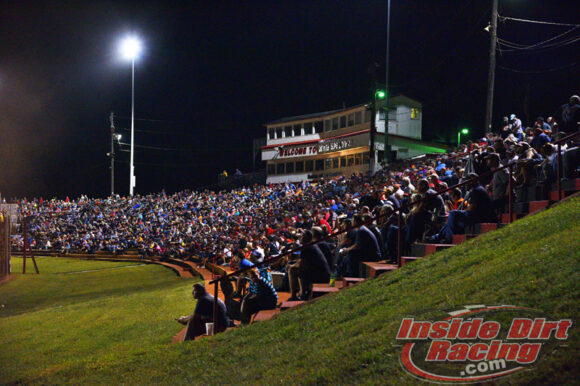Why is your favorite race track your favorite race track?
There can be any number of reasons why you picked the track you picked for the above question. Proximity to your home, people you enjoy being around, the concession stand, the quality of the competition, the way the place is run, and a multitude of other qualities probably play a role in deciding that question for you.
But above all things, I have compiled a list of 5 things that I believe every dirt track should have in order to make the place special for both its patrons and its competitors.
Here is my list:
1. Efficiency– Michael Moats and I have harped on this frequently in our Turn 2 Blog pieces and otherwise. And to begin with, I will say that a number of tracks I have gone to over the past couple of years seem to be putting their best foot forward when it comes to running an efficient program.
Personally, one of my biggest annoyances is to feel as though my time is being wasted. As a teacher, I can’t stand burning up my planning period with a needlessly long faculty meeting, the content of which could have been just as easily covered in an email. As a parent, I hate sitting through some type of orientation while other parents ask questions that have common sense answers. As a customer, I am bothered by restaurants that tell you there will be a twenty minute wait when it is obvious they have open tables.
I’m guessing many of those same things are true for most of you.
If that is the case, dirt tracks should not be looking for ways to waste the time of their customers. Keep the show running unless there is some issue that could not have been foreseen. If drivers won’t get lined up for hot laps, qualifying, or their heat races in a timely manner, don’t wait on them. Either tell them they missed their turn completely or move that class to the end of the program.
Also, have everything ready to go on time. If you advertise that hot laps will start of 7:00pm then the first cars should be rolling on the track at that time. There are some tracks I go to in which I know they are not going to start at the advertised time, and sure enough, track prep will be nowhere near complete when hot laps are supposed to start so fans wind up having their time wasted while they watch packer vehicles circle the oval for another 20-30 minutes.
Furthermore, have enough equipment and personnel to handle whatever situation may arise. There should be more than one wrecker and enough people to get fluid on the track covered when that inevitable problem occurs.
And lastly, be aware that when you have a big show such as a Super Late Model race, there might be fans who have driven three or four hours to watch that race and are facing a three to four hour drive home at the end of the night. For that reason, the primary feature should never be the last to run. As a matter of fact, promoters should challenge themselves to have their main event of the night taking the green flag by 10:00pm so it should be placed somewhere within the program so that can happen. Doing so will encourage the fans who have driven long distances to come back because they will know they won’t be getting home at 4:00am.
Whether it actually has one or not, every track should operate as if there is a curfew. A sport that says it wants more young people to be involved seems to, at times, do things that would cause a young child to dread being dragged to a race track because they know it’s going to be a long and miserable night for them that drags into the early morning hours. Five-year-old kids and their parents don’t have the endurance for a marathon and if race tracks turn their nights into one, those folks will stop coming.
Be on time. Be efficient. Be mindful of wasted moments.
2. Cleanliness– Along with a lack of efficiency, filth will keep customers from returning as well. But with that said, I am going to throw some of this back on the fans. I have gone into some restrooms that were clean at the beginning of the night only to return a couple of hours later to find the same facility a nasty mess. It’s not very likely that the promoter came in and caused that.
There are a couple of tracks I go to in which the porta-potty is a better option than an actually restroom, even at the beginning of the night. That should never be the case.
That said, every track should at least begin a race night with their best foot forward. Restrooms, concession areas, and the grandstands should be free of trash and well stocked. Also, there should be plenty of trash receptacles and they should be appropriately placed. This will make life easier for both the spectators and the cleanup crew.
As someone who has helped to clean a race track following a big event, this is not an easy task. At the same time, it is a necessary one. Most of us wouldn’t shop in a business that had trash just lying around and had restrooms that we are leery of going into. Dirt tracks can’t expect otherwise.
3. An Appropriate Number of Classes– Part of the reason why some tracks struggle with running an efficient program is the number classes they run on a typical or a special race night. Personally, I have intentionally not gone to certain events after looking at the schedule for the evening of a particular race to see that six, seven, or even eight classes are on the program for that event. That is quite simply too many.
There is no bigger waste of time than for a track to hot lap, heat race, and feature race a division that has only four or five cars.
Having too many classes is a sure fire way to drop the ball when it comes to running an efficient show as each class has to hot lap, qualify and/or heat race, then run a feature. But in my opinion, a bigger issue when it comes to a track hosting too many classes is that doing so dilutes the pool of drivers in each one.
In east Tennessee, there are can be as many as four different Late Model classes. But the most frustrating thing about that for many fans is that the features for those divisions may only have six or eight cars apiece. That leads to the inevitable question of why the track doesn’t combine two or three of those to have a race with a full field.
From what I have seen, a track may start up a class that begins to build and reach decent car count numbers. Invariably though, someone will complain about a rule or the fact that one particular driver wins too often and the track decides to split the class in an attempt to make everyone happy. That leads to small fields.
Obviously, promoters want to keep as many of their drivers as happy as they can because of the revenue generated at the pit gate and some see splitting up classes as a way of doing that. I don’t have any money invested in running a track, but as a fan, watching features with too few cars is not very entertaining nor enticing.
4. Communication– As a media member, lack of communication from tracks, series, and competitors is one of the most frustrating things about covering the sport. While fans of dirt racing like to criticize NASCAR about this and that, one thing they could definitely learn a lesson from is that side of the sport’s use of the communication tools it has at its disposal. Virtually every driver, the entire series, and every track has a very active presence on websites and social media.
And the argument that it’s too expensive for dirt racing does not hold water. Yes, NASCAR can afford to have teams of people working on websites and social media accounts. But the reality is that it costs very little to have a simple website set up and social media accounts such as Twitter and Facebook are essentially free.
Let me add here that there are some in dirt racing who do an excellent job at providing information. Others could learn from those examples.
There are times when I have tried to find information about a certain event but it is almost as if the track or the series are trying to keep the information a secret. I have looked at driver websites and Twitter accounts that have not been updated in weeks or sometimes even months. There are even some high profile drivers who have very poorly kept websites and social media accounts.
The counter some might offer when asked why they don’t do better is to say that their job is to drive a race car or operate a track and not to be on Twitter. Actually, the job of drivers and tracks is to promote themselves so people will know if you actually do a good job of driving or running a facility. If no one knows what you are doing, does it really even matter?
It’s not up to the fans to research what you are doing. It’s the job of those involved in the sport to inform them. We all must do better here.
5. A Good Announcer– Not only is it important that tracks communicate well away from their facility but it’s also important that they communicate well at the track. And of course, this is primarily done through the public address announcer.
The best announcers are informative and they have learned how to be so in a very hostile environment. Listing the top-5 qualifiers does little good if it is done with all the engines running. Unfortunately, some will call out qualifying times as the drivers complete their laps then never give a rundown of the top-5 or top-10 but will simply move on to the next class.
Not every fan in attendance knows who is driving each car. Because of that, giving a rundown during a caution period can be very helpful, particularly to the new fan. The best announcers are able to keep the new fan informed while not seeming too simplistic for the regular patron.
And lastly, everyone knows there is a concession stand so use the breaks in the action to tell everyone something useful. Again, there are many who do this very well but all should strive.
*****
That is my list of things all dirt tracks should have. Many tracks do some of these things well and a few even do all of them well. It should be the aim of all involved to constantly seek improvement in every aspect. That’s what successful businesses do.
Respond to this post on Twitter by following @RichardAllenIDR and @MichaelRMoats or by liking the InsideDirtRacing.com Facebook page.
Also, NASCAR and pavement racing fans can check out InsideCircleTrack.






